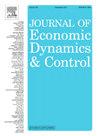Liquidity allocation and endogenous aggregate risks
IF 2.3
3区 经济学
Q2 ECONOMICS
引用次数: 0
Abstract
This paper presents a continuous-time DSGE model that examines an endogenous mechanism for liquidity allocation between the real economy and the financial system, as well as its interaction with systemic risk. The model provides rationales for the phenomena of weak investment and a savings glut observed among non-financial corporations in major advanced economies during the recovery from the Great Recession. It highlights that physical capital has lower liquidity compared to its corresponding equities. By incorporating financial frictions, the model reveals that risk-averse entrepreneurs, who must bear a portion of their investment risks, have their investment decisions significantly shaped by their capital structure. When entrepreneurs face low net worth, they tend to reduce investments and increase holdings in financial assets as a risk hedge. This behavior shifts more funds into the financial system, potentially sparking a financial boom accompanied by elevated systemic risks, while contributing to a sluggish economic recovery.
流动性配置与内生总量风险
本文提出了一个连续时间DSGE模型,该模型考察了实体经济和金融体系之间流动性配置的内生机制,以及它与系统性风险的相互作用。该模型为大衰退复苏期间主要发达经济体非金融企业中出现的投资疲软和储蓄过剩现象提供了理论依据。它强调,实物资本的流动性低于相应的股票。通过纳入金融摩擦,该模型揭示了风险厌恶型企业家的投资决策在很大程度上受到其资本结构的影响,他们必须承担一部分投资风险。当企业家面临低净值时,他们倾向于减少投资,增加金融资产的持有,作为风险对冲。这种行为将更多资金转移到金融体系,可能引发金融繁荣,同时增加系统性风险,同时导致经济复苏乏力。
本文章由计算机程序翻译,如有差异,请以英文原文为准。
求助全文
约1分钟内获得全文
求助全文
来源期刊

Journal of Economic Dynamics & Control
ECONOMICS-
CiteScore
3.10
自引率
10.50%
发文量
199
期刊介绍:
The journal provides an outlet for publication of research concerning all theoretical and empirical aspects of economic dynamics and control as well as the development and use of computational methods in economics and finance. Contributions regarding computational methods may include, but are not restricted to, artificial intelligence, databases, decision support systems, genetic algorithms, modelling languages, neural networks, numerical algorithms for optimization, control and equilibria, parallel computing and qualitative reasoning.
 求助内容:
求助内容: 应助结果提醒方式:
应助结果提醒方式:


